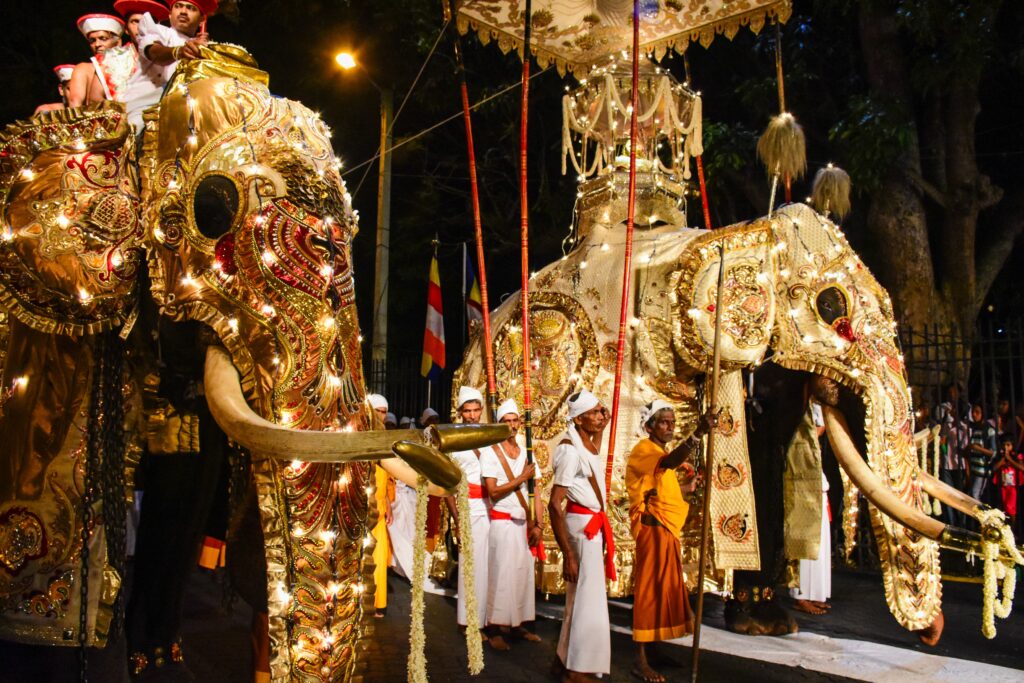Every year, as the full moon of Esala rises over the hills of Kandy, the streets come alive with one of Sri Lanka’s most magnificent cultural spectacles. The Esala Perahera, also known as the Festival of the Tooth, is a grand procession that pays homage to the Sacred Tooth Relic of the Buddha. Rich in tradition, spirituality, and artistry, this centuries-old celebration is one of the oldest and most elaborate Buddhist festivals in the world. For both locals and travellers, witnessing the Esala Perahera is not just an event; it is an experience that leaves an unforgettable mark on the soul.
Held annually in July or August, the Esala Perahera stretches across ten vibrant nights, with each evening building in grandeur. The festival is deeply rooted in both religious reverence and cultural pride. At its heart lies the Temple of the Tooth Relic, or Sri Dalada Maligawa, which houses the sacred relic believed to be a tooth of Lord Buddha. The Perahera serves as a public display of devotion and a request for blessings such as rainfall, prosperity, and peace for the country.
What makes the Esala Perahera truly remarkable is the sheer scale of its pageantry. As night falls, the city of Kandy transforms into a glowing stage illuminated by torchlight and resonant with the sounds of traditional drums and flutes. The streets fill with dancers, acrobats, fire-breathers, whip crackers, and elaborately dressed elephants, all moving in perfect harmony. Each group, or Perahera, is led by whip crackers who clear the path with rhythmic snaps, followed by drummers and dancers who perform time-honoured routines passed down through generations.
At the heart of the procession is the majestic Maligawa Tusker, an ornately adorned elephant who carries the golden casket known as the karanduwa. This casket symbolically holds the Sacred Tooth Relic during the parade. The elephant’s costume is lavishly decorated with lights, sequins, and embroidered fabric, turning the gentle giant into a walking work of art. Devotees often bow their heads as the tusker passes, offering prayers in silent reverence.
There are multiple processions within the Perahera. The first five nights are known as the Kumbal Perahera, where the ceremony begins modestly and gradually gains momentum. The second half of the festival is called the Randoli Perahera, named after the royal palanquins used during ancient times. These nights see the most extravagant displays, with the most significant number of performers and the most ornately dressed elephants. The final night, or the Grand Perahera, is a breathtaking culmination of spiritual energy and artistic brilliance.
The origins of the Esala Perahera date back to the 3rd century AD, during the reign of King Kirthi Sri Meghavarna. It was believed that by parading the Tooth Relic through the streets, divine blessings would be bestowed upon the land. Over the centuries, the event has evolved into a blend of Buddhist and Hindu traditions, incorporating elements from the devales, or shrines, dedicated to the four guardian deities: Natha, Vishnu, Kataragama, and Pattini. Each devale has its mini-perahera within the larger event, contributing unique costumes, music, and rituals.
What sets the Esala Perahera apart from other festivals is the deep spiritual energy that runs through every aspect of the celebration. It is not merely a performance; it is a living expression of faith, devotion, and national identity. Locals often fast or engage in acts of merit during the days leading up to the event, while performers undergo purification rituals to prepare themselves. For many Sri Lankans, participation in the Perahera is a sacred duty and a source of immense pride.
Travellers lucky enough to attend the Esala Perahera should plan well in advance, as accommodations in Kandy fill up quickly during the festival period. Viewing spots along the procession route are highly sought after, with many choosing to book seating through hotels or tour operators. Wearing modest attire and behaving respectfully is essential, as the Perahera is a religious event at its core.
For photographers and culture lovers, the festival offers a treasure trove of vibrant visuals and moments. From the hypnotic movements of Kandyan dancers to the thunderous echo of ceremonial drums, every second is infused with energy and meaning. Yet beyond the visual splendour lies a more profound truth: the Esala Perahera is a timeless bridge between past and present, a living tradition that continues to bind communities, generations, and beliefs in a shared celebration of faith.
As the final tusker disappears into the night and the torches fade, the magic of the Esala Perahera lingers. It is more than a festival; it is a journey into the spiritual soul of Sri Lanka, where devotion dances in rhythm with tradition, and history shines beneath a moonlit sky.

